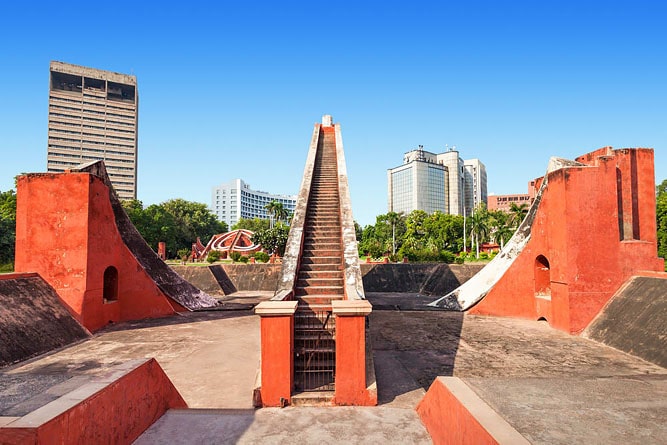Jantar Mantar
Historic site in Jaipur
should-see attraction
Opening hours: 9:00am-4:30pm
Address: Gangori Bazaar, J.D.A. Market, Pink City, Jaipur, Rajasthan
Ticket price: Indian/foreigner ₹50/200, guide ₹200, audio guide ₹100
Visit duration: People typically spend 30 minutes to 1 hour here
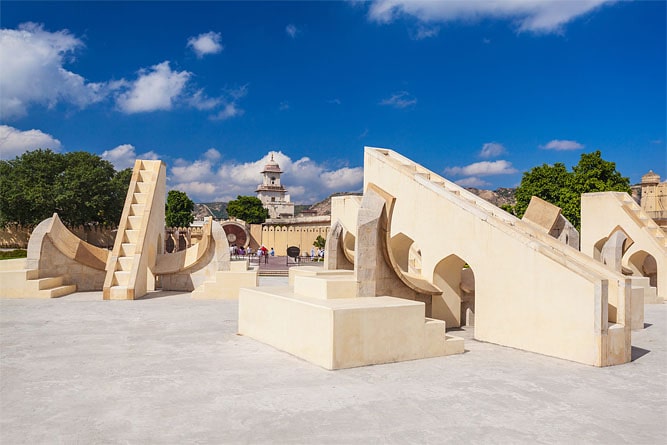
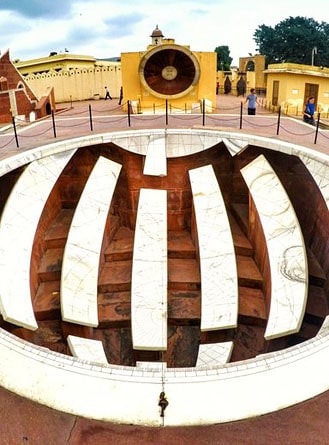
About Jantar Mantar, Jaipur
Jantar Mantar is one of the most famous tourist attractions of Jaipur. An astronomical observatory built in 1734 by Sawai Jai Singh II, Jaipur’s Jantar Mantar is one of the 4 more Jantar Mantar in the country across different states. In Jaipur, Jantar Mantar is located near the Hawa Mahal and the City Palace.
The observatory features the world’s largest stone sundial along with 19 astronomical devices that resemble a collection of gigantic structures. These instruments were made by carving stone and brass.
It is astounding how the instruments built more than two centuries ago allow you to observe astronomical positions through naked eyes! The engineering marvel of Jantar Mantar is unsurpassable.
Each of the 19 astronomical devices in the Jantar Mantar of Jaipur helps in understanding local time, predicting eclipses, tracking the position of stars and also determining the celestial altitudes.
The working of the devices in the Jantar Mantar is based on principles of the classical celestial coordinates. The principles include the horizon-zenith local system, the ecliptic system and the equatorial system. It is through the use of these three systems that researchers could track the position of celestial bodies in space.
History of Jantar Mantar, Jaipur
While most kings found their passion in town planning and battles, Sawai Jai Singh II, a renowned scholar of his time, developed his interest in astronomy.
It was during Emperor Muhammad Shah’s reign that he assigned Jai Singh a task to provide confirmation and subsequent rectification of the celestial position and movement data that was available.
Jai Singh was strong-willed and absolutely determined to determine the exact time by refining the age-old Islamic Zij. He set an objective to create a properly detailed calendar. His interest and belief in astrology were also persistent as he wished to use it for the benefit of humankind.
The date was set. Jai Singh decided to build Jantar Mantar in the year 1718 which would help him turn his dreams into reality. He set out on a mission to deeply study cosmological principles that had been laid down by notable philosophers belonging to different civilizations.
Jai Singh's interest, combined with his vast knowledge of space, led to 5 such astronomical observatories. Jaipur's Jantar Mantar is the largest and the most well-preserved one after its frequent renovations between 1727 to 1733.
The astronomical wonder of the 18th century was included in the list of India’s UNESCO world heritage sites in the year 2010.
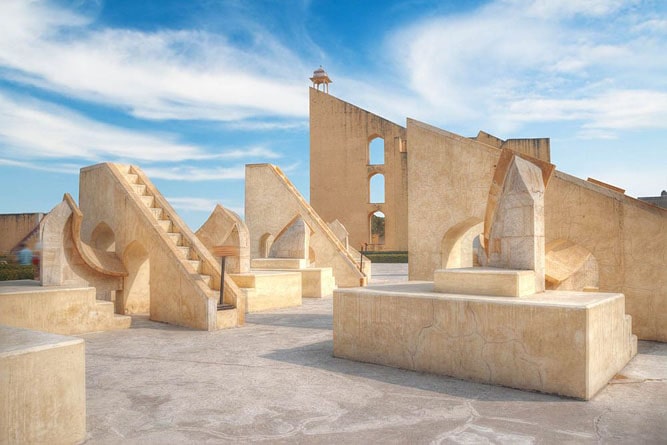
The major attractions at Jantar Mantar, Jaipur
The 19 gigantic astronomical devices all have specific applications and history. To get the best experience at Jantar Mantar of Jaipur, you can hire a guide and get ready to be amazed by the more than 280 years old instruments.
Vrihat Samrat Yantra: The Vrihat Samrat Yantra is the massive sundial at the centre of the observatory. It is 27 metres in length and is built with triangular walls. The shadow of these walls moves equal distances in equal time lengths. At a precision of two seconds, this equinoctial sundial measures time following the shadow of the walls.
Laghu Smarat Yantra: As the name suggests, this is a smaller sundial. It has a ramp that points towards the North Pole. The movement of the ramp’s shadow on the carved scale with finer divisions helps to calculate the local time of the city at an accuracy of twenty seconds.
Ram Yantra: This instrument can only be seen in Jaipur’s Jantar Mantar. The Ram Yantra helps to measure the elevation and the azimuth of celestial bodies and the Sun. There are circular walls and tube-like structures that are open towards the sky
There are other various interesting instruments that are bound to make you think about how these were built with such precision years ago. Some of the other magnificent instruments include the Chakra Yantra, Digamsa Yantra, and Nadivalaya among others.
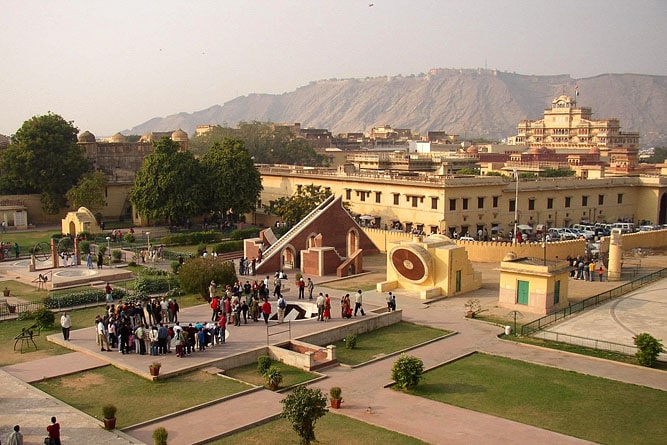
Entry fee and timings
Located at the Gangori Bazaar, J.D.A. Market, Pink City in Jaipur, the Jantar Mantar has different entry fees for Indian nationals and foreign tourists. Indians have to pay ₹50 while the entry fee for foreigners is ₹200.
The Jantar Mantar of Jaipur is open from 9:00 am to 4:30 pm on all days of the week. Depending on how much you want to know about the instruments, you can spend around an hour or so in this place.
Facts and tips about Jantar Mantar
- The name Jantar Mantar has been derived from two Sanskrit words 'yantra' and 'mantrana'. Yantra means an instrument or a machine, mantrana means to calculate. So, the name of the observatory literally means an instrument to calculate.
- There is a building inside the Jantar Mantar called the orientation building which schedules short films to brief visitors about the observatory and its evolution.
- If you plan to visit Jantar Mantar in the summer, then consider going as soon as it opens or in the evening so that you can look around and appreciate the marvellous creation.
How to reach Jantar Mantar
Jantar Mantar is located in Jaipur's city centre. The astronomical observatory is just next to the City Palace and within walking distance from Hawa Mahal.
See location on Google Maps
Other attractions near Jantar Mantar
- City Palace - 130m
- Hawa Mahal - 700m
- Albert Hall Museum - 2.5 km
- Amber Palace (Amer Fort) - 8.2 km
- Nahargarh Fort - 14 km
FAQs about Jantar Mantar
1. How much time does it take to take a 360-degree tour of Jantar Mantar Jaipur?
It depends on your pace and how much time you spend understanding the instruments. If you just want to take a complete tour of Jantar Mantar, it will take you around 30 minutes.
2. Is the observatory open during public holidays?
Yes, Jantar Mantar is open all days of the year.
3.What should I carry with me when touring the Jantar Mantar?
Carry at least two bottles of water when touring the Jantar Mantar to keep yourself hydrated.
4. Can I click photographs inside the observatory?
Yes, you can click photographs and shoot videos inside the observatory by paying a nominal fee.
